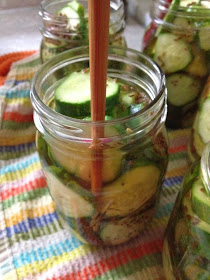 |
| Removing air bubbles from a jar of Quick Dills with Garlic and Chile |
Then, one day a long time ago, I was cleaning out the kitchen drawers and stumbled upon one lone chopstick, a leftover from my we-will-eat-Chinese-food-with-chopsticks kick. I started to throw it out, but then I thought this could be great when canning. Now I know some of you came to this pretty obvious conclusion long before me, and kudos to you if you did. You probably stopped dreading bubbling your jars long before I did. If you haven't ever thought about it though, consider it for a moment.
You need to remove air bubbles from your jars for a variety of reasons, most of which involve, get this, the amount of air in the jar. Crazy, huh? All joking aside, air bubbles really do need to be done away with as best as possible. They can cause a variety of problems, most of which aren't necessarily safety related, but can be aggravating and cause canned goods to be less than desirable. Trapped air makes it difficult to achieve proper headspace in the jar. This is important in getting a good seal. If you've ever canned, you've noticed that after you remove bubbles from a filled jar, the liquid level almost always needs to be adjusted. That's because you removed the air and liquid filled those spaces where air used to be. If you don't remove that air, it can mess up the headspace of the jar and even force liquid to seep out of the lid before it seals. The food in the jar will still be safe so long as you achieved a seal, but the liquid loss can be messy, sticky, and most of all, it can cause the food at the top of the jar to discolor from being exposed to air. This discolored food is still safe to eat, but when faced with a brown peach slice and a nice peachy peach slice, which would you want most? Seepage can also weaken a seal and cause it to fail over time.
 |
| Using a chopstick to gently press the foods in the jar inward to remove air bubbles on side. |
Here's where the chopstick is super helpful. Chopsticks are usually made of wood or plastic (don't use metal, not that you could probably find a metal chopstick anyway), so they are nonreactive with vinegar and other acid foods. They are safe to use with glass jars and will not cause dings and cracks in the glass over time as much as more rigid tools. They are small and can easily squeeze into spaces between foods where other tools can't go. They can also squeeze in between foods without pushing too much on the foods and moving them around. I mean, who wants the tool to rearrange the jar after you so carefully packed it? Right? Since they are small and straight, they are great for lightly pressing backward on foods to draw the foods toward the center of the jar and help release air bubbles along the edge of the jar. And as if all this weren't enough, the blunt end of the chopstick is a great tool to help you arrange and pack foods like cucumber slices into regular mouth jars where your fingers can't easily fit. I use the blunt end to keep from stabbing the foods when using it to arrange, and it's also helpful to have two chopsticks so you can use both ends without getting sticky or having to clean the chopstick in between uses.
So, if you haven't considered using a chopstick for removing air bubbles, try it out. You may be like me and begin to remove bubbles without dread.













